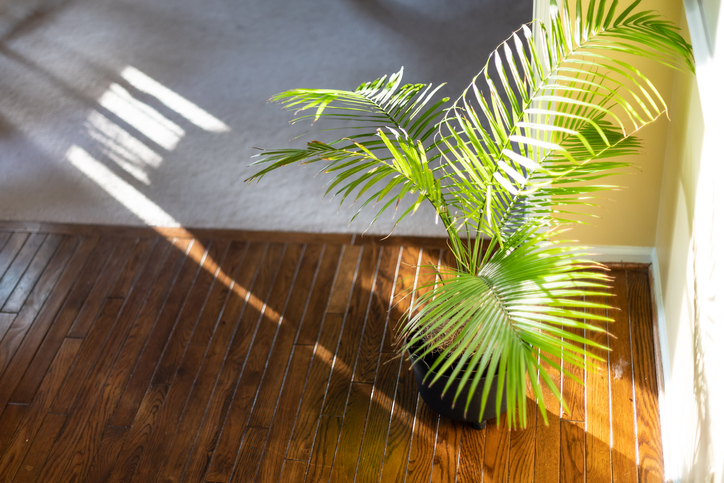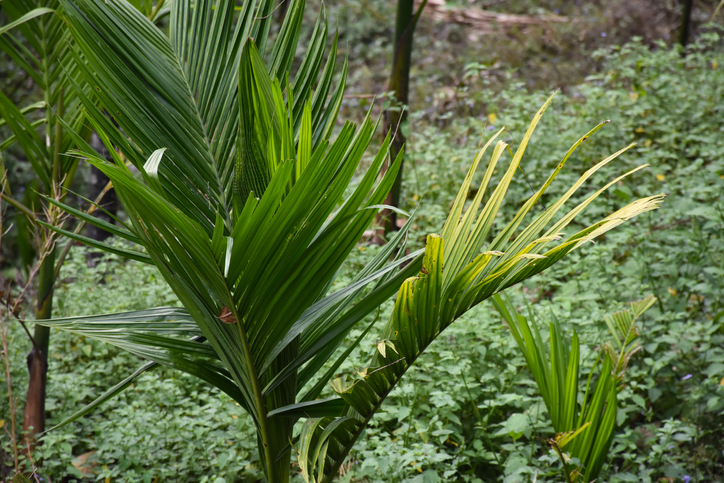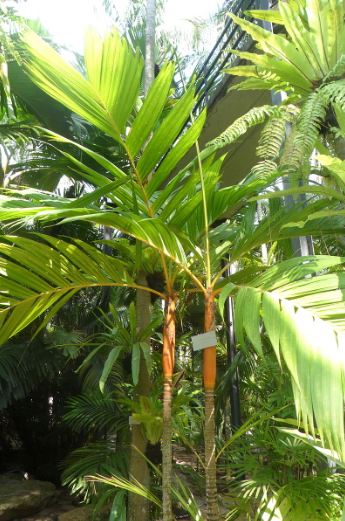Areca is a genus of the family Arecaceae. Areca nut is also known as supari tree/Areca palm, the most common genus of this family. It is a well-known and usually grown palm tree in Southeast Asia. Moreover, it is an antidepressant drug widely used by 10-20% of the world population. Among abused substances of the world, the Areca nut is at number four; it is related to oral cancer.
Biomarkers through the process of pathogenesis are used to identify people who are addicted to areca. It is also known as Betelnut because it is chewed raw with betel leaves. It has a bitter taste used in raw form in combination with betel leaves.
Botanical Facts
Areca is a genus of palm that belongs to the family Arecaceae. The well-known member of this genus is the Areca catechu tree, whose seed is Areca nut, also known as betel nut. The family Arecaceae from which areca belong has a total of 200 genera and 2600 species.
Areca nut is commonly found in tropical forests of Asia and Africa. And in Asia, it is most commonly found in India, the Philippines, and Malaysia – mainly in Asia’s southern parts. It grows in regions where winter is mild, is sensitive to low temperatures, and could not bear temperatures less than 10°C. The maximum height it can grow to is 20-28 feet. It gets its generic name from the Malabar Coast of India.
Features

If you drive through any of the subtropical climates, you will get a chance to see a number of this tall and alluring cluster of palms with a strong resemblance to bamboo. The trunks of Areca palm/Areca nuts are smooth and have a yellowish or golden appearance.
Areca palms are well known for being of an average height of around 20m. Half of this height is taken up by the trunk. The trunk, when compared to other trees, is small at only 10 to 15cm in diameter. The leaves are quite large and measure at around 1.5 to 2m long. These leaves are often shed around 5 to 6 times per year.
The fruits that these plant bears are usually orange in color. Each of them has a single seed which is usually hard.
When the suckers are removed, these palm trees show similarity with bamboo. If grown outdoors, these can grow up to the height of 20-28 feet, and when grown indoors, they can be 6-7 feet high. These plants can bear trimming.
Areca plants grow in bright light but not direct sunlight. Although it is an evergreen plant, if exposed to direct sunlight, it can die.
How to Grow Areca?

Whether you are growing Areca indoors or outdoors, you have to follow the following instructions:
Humidity
Areca plants grow best in high humidity. If you are growing it outdoors, then that’s not a problem, but indoors you have to make sure that the air is not dry, because if it is, the leaves will turn brown. Areca plants can grow at normal room temperature. If the air inside is dry, place your plant in a tray with pebbles and water. The evaporation of water prevents dry air and prevents your plant from dying.
Temperature
Areca plants are susceptible to low temperatures. It needs a temperature between 18-25°C. While growing, ensure that the temperature never drops to 10oC. If you are growing it indoors, keep it away from air conditioners or any region where the temperature is low.
And while growing outdoors, don’t keep it near doorways because the temperature is generally cold around doorways. Protect your plant from sudden temperature drop because it will bring dark spots on the leaves.
Light
Areca palm needs bright sunlight for its growth. It is a part-shaded plant that needs light but not direct sunlight. If exposed to direct light, the leaves will turn yellow/brown, and your plant will be dead. While growing it outside, keep it in shady places, while indoors, place your plant in a room where bright sunlight comes from the southwest facing window, and filter the light by covering windows with curtains, preventing your plant from direct sunlight.
Soil
Your plant will be happy outdoors in slightly acidic soil. If you are growing it indoors, then keep it in soil with excellent drainage. If the drainage is poor, it will lead to waterlogging, and the leaves will turn yellow.
To lower the PH of the soil, add some sand, peat moss, and bark mixture. After every three years, re-pot it to remove old soil.
Fertilizer
Areca grows best in nutrient-rich soil; if any major salt is missing, such as magnesium and iron, it will not show proper growth. That’s why it is highly recommended to add weak liquid fertilizer during the growing season.
Watering
If you want your Areca plant to grow perfectly, then avoid overwatering. The best method to water your plant is to let the soil dry. To check this, put your finger in the soil around one or two inches deep. If you feel dry soil, add water. On the other hand, if you feel moist soil, wait for at least two days and test again.
During summers, it needs more water, but make sure that the soil is not too soggy. For good water drainage, add some pebbles at the end of the pot. Don’t use water that contains fluorides. If you are living in a region in which tap water has fluorides, then use distilled water.
Propagating
It isn’t easy to find Areca plant seeds. However, if you manage to find the seeds, you can germinate them at home. The germination process takes six months if the temperature is over 80° F and in high humidity. Place the seed at a uniform depth. Try to find old seeds because their germination rate is faster as compared to new green seeds.
Benefits of Keeping/Growing This Plant

1. Enhance Humidity
Keeping the areca plant inside enhances humidity. If you have any respiratory problems, you can keep this plant in your home to decrease dry air and breathe fresh.
2. Low Maintenance
It doesn’t need much maintenance like other indoor plants. You don’t need to water it regularly – do it after three days.
3. Increases productivity
According to a survey, keeping plants indoors increases your work productivity. It increases your concentration.
4. Releases oxygen
Areca palm is one of those plants whose leaves have a large surface area, and such plants release more oxygen. Moreover, it also absorbs pollutants from indoors.
Areca – A Toxic Drug
According to an estimate, around 10-20% of the world population is addicted to areca nuts. Although it is not common in the United States, it is the most commonly used hallucinogenic drug after caffeine, nicotine, and alcohol. Areca palm is grown in tropical and subtropical regions of the world. The nuts of these palms are used either raw, baked, roasted, or fermented. These are consumed with betel nuts, that’s why they are called Palm nut. Sometimes, it is consumed with some spices and tobacco.
It is known to be a cause of oral cancer, especially in India and Taiwan. In these two countries, cases of oral cancer are increasing rapidly. And areca nuts are known to be correlated with oral cancer. In case of an overdose of this drug, symptoms of oral cancer can be seen clearly. Some symptoms include nausea, vomiting, urinary incontinence, and hypersalivation.
Despite all of its harmful effects, it is sold commonly worldwide. Areca nut’s industry makes$3 billion every year. In India, the common names for areca nuts are pan masala and gutka. 80% of areca nuts are prepared without tobacco and are not harmful.
According to research, cases of oral cancer due to Betel nut in different regions are as follows:
- China: 0.9-4.7%
- India: 0.4-10%
However, in recent times there is a decrease in cases of cancer, and now the rate is 7.6 %
- Pakistan: 8.9 %
The number of patients with oral submucous fibrosis due to areca nuts has increased in Pakistan.
FAQ- Everything about Areca
1. How much time does an Areca plant need to grow?
Areca plants are known to grow to around 10 feet tall every year and their roots also spread. The spreading of roots is mostly horizontally from where it is planted. This growth, however, only happens in areas that are ideal for the Areca plant.
Ideal conditions for the Areca plant include a highly humid environment that has a moderate temperature of around 18-25 degrees centigrade. Bright sunlight paired with acidic soil is also perfect for Areca plants to grow in.
However, if you are growing the Areca plant, it is essential that you do not overwater them. Overwatering can be extremely detrimental to it.
If all the ideal conditions are met, the plant should take not more than two to three years to grow into a mature plant.
2. Do you keep Areca plants inside or outside?
Areca plants need a lot of sunlight to grow. They thrive and grow to their fullest height when they receive adequate light whether that be through sunlight or indirect light. That does not mean that they need sunlight all the time, they can work through a bit of shade as well.
However, you should be mindful of not keeping your Areca plants in direct sunlight. Direct exposure to extended amounts of time can do the complete opposite of helping them grow. The leaves may get scorched and that is not something you as the owner want. It is also better for the plant if you keep it away from any sort of draught.
Due to their need for adequate light, Areca plants can be kept inside or outside as well. If we talk of idea conditions, we suggest placing them in a warm room that has an average temperature of around 18 to 24 degrees centigrade. The minimum temperature it can handle is 10 degrees centigrade. Make sure it never goes below that even in winters.
3. How much water does an Areca plant need?
Areca plants do not need a lot of water to survive hence, we should always ensure that it has adequate water.
Watering should be done regularly for this plant. The best way to go about watering this plant is to allow the soil mix to dry from the surface. Once it is dry, that means that it should be watered again.
Through this method, you can ensure that your plant is watered but not overwatered. Overwatering an Areca plant causes the plant’s roots to suffocate. Due to the suffocation, it cannot grow properly. In extreme cases of overwatering, it can also die.
The ideal gap between watering it is around 2 to 3 days.
4. Does the Areca palm produce flowers?
Yes, the Areca palm is a plant that has a rather normal growing trajectory.
This plant can grow up to be 20ft tall. However, its height comes after its width. This plant grows wider before it grows taller so don’t be too alarmed by the increase in width.
Around late spring and early summer, the Areca palm will usually produce small flowers. These flowers usually grow beneath the leaves and are bright yellow in color. Additionally, these flowers have male and female flowers in the same inflorescence. This arrangement makes pollination quite easy.
Conclusion
Areca is a beautiful plant, and when you grow it indoors, it increases the beautification of your house, absorbs pollutants, and increases humidity. However, the nut that grows in this plant can be harmful if taken with tobacco.

